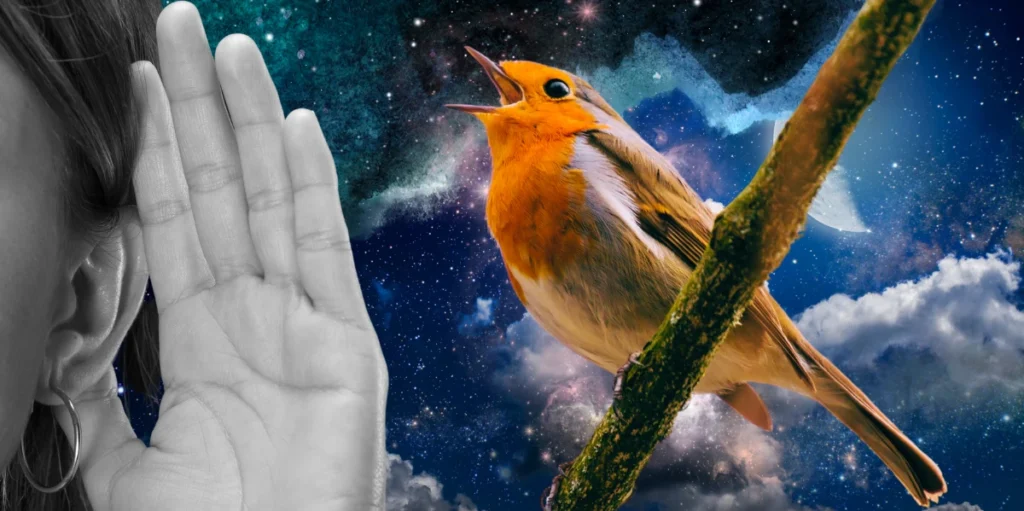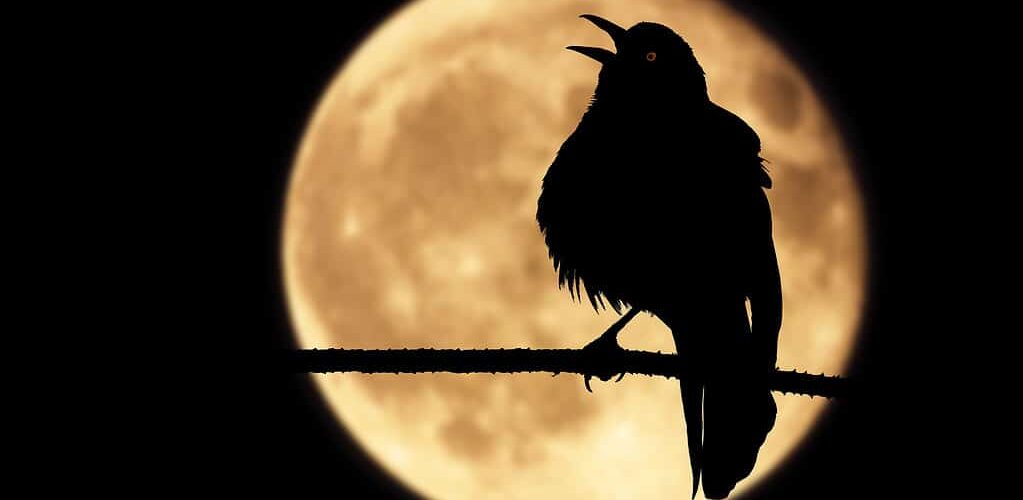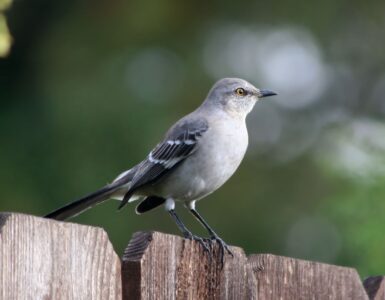Birds chirping at 1 AM can seem like a mysterious and enchanting phenomenon, often stirring the human soul and igniting a sense of wonder. This article delves into the spiritual significance of nocturnal birdsong, exploring its cultural importance, environmental implications, and the deep connection it fosters between nature and the human spirit. We uncover the layers of meaning behind the nighttime symphony of birds and reflect on how these avian melodies can influence our lives and beliefs.

Key Takeaways
- Nocturnal birdsong serves as a powerful symbol in various cultures, representing divine messages and the spiritual awakening of the soul.
- The presence or absence of birdsong at night can be an indicator of environmental health, with silence often signaling ecological distress.
- Urban landscapes, like Beverly Hills, showcase a notable silence that prompts a reflection on habitat loss and the need for nature’s soundscape.
- Literature and religion have long celebrated birdsong as a form of natural worship and a reminder of the interconnectedness of all life.
- Fostering urban bird habitats and community engagement can help preserve the nighttime chorus, enriching our spiritual and environmental experience.
The Enigmatic Chorus of the Night
Deciphering the Language of Birds After Dark
As the sun sets and darkness envelops the sky, a different ensemble of birds take the stage, their chirps and songs piercing the quiet of the night. The nocturnal serenade is more than a mere background noise; it is a complex communication network. Each species has its own distinct call, a language developed to meet their unique nocturnal needs. These sounds range from the soft hoots of owls to the sharp calls of nightjars, each with a purpose, be it mating, hunting, or signaling danger.
The reasons behind these vocalizations are as varied as the birds themselves. Some birds, like the nightingale, are known for their powerful and melodic songs that they use to attract mates and defend their territory. Others may chirp at night due to disorientation, artificial lighting, or changes in their environment. To better understand these mysterious nocturnal tunes, consider the following points:
- Communication: Birds use songs and calls to communicate with each other, conveying messages about food, danger, and mating.
- Territory: Nocturnal singing can be a way for birds to claim and defend their territory during the hours when other birds are less active.
- Disorientation: Artificial lights and urban noise can disrupt birds’ natural behaviors, leading to increased nocturnal chirping.
While the darkness may obscure our view, it amplifies our sense of hearing, allowing us to tune into this nightly chorus with greater clarity. The night, often associated with silence, is alive with the whispers and cries of our feathered companions, each note a thread in the tapestry of the night’s soundscape.
The Rarity of Nocturnal Birdsong in Urban Landscapes
In the bustling urban landscapes, the once-familiar chorus of nocturnal birdsong has become a rare serenade. The absence of this natural music in the city nights speaks volumes about the changes in our environment. Urbanization has not only altered the skyline but also the acoustic ecology, leading to a significant reduction in the presence of birds that sing at night.
- Urban light pollution disrupts the natural behaviors of nocturnal birds.
- Noise from traffic and human activity drowns out the softer calls of night singers.
- Habitat destruction limits the spaces where these birds can thrive.
The contrast between the vibrant daytime bird activity and the hushed nights underscores the impact of city life on our feathered companions. The silence that fills the air after dark is a stark reminder of the biodiversity we stand to lose.
The timing of singing for urban and rural birds also differs. A study on great tits, Parus major, revealed that those in urban areas sing earlier dawn choruses but are less vocal during the day compared to their rural counterparts. This adaptation to urban life may further diminish the chances of hearing their melodies at 1 AM, as they conserve energy for their pre-dawn performances.
Spiritual Interpretations of Midnight Avian Melodies
The stillness of the night is often pierced by the unexpected chorus of birdsong, a phenomenon that holds deep spiritual significance for many. Birds chirping at 1 AM are not merely a biological behavior but a tapestry of mystical messages woven into the night. These nocturnal serenades are interpreted as communications from the divine, carrying with them profound meanings that resonate with the human soul.
- Robins chirping at night are seen as harbingers of hope and rebirth, echoing the spiritual teachings of various cultures.
- The persistent melodies of night-singing birds can symbolize persistence and resilience, reflecting life’s continuous cycle despite the darkness.
- For some, the clarity of birdsong in the quiet of the night represents insight and enlightenment, a call to introspection and meditation.
In the hush of midnight, the birds’ songs emerge as a sacred symphony, inviting us to pause and reflect on the mysteries that unfold under the cloak of darkness.
Birdsong as a Barometer of Environmental Health

Silent Spring Revisited: The Ominous Quiet
The haunting silence that has replaced the once vibrant birdsong in many areas is a stark reminder of the environmental changes impacting our avian companions. The absence of chirping is not just a loss of natural music; it’s a warning sign of ecological imbalance.
In areas where birds were once a common presence, their silence now raises questions about the health of our ecosystems. The decline in birdsong can be attributed to various factors:
- Habitat loss and fragmentation
- Pollution and climate change
- Pesticide use affecting food sources
- Predation by domestic animals
The quiet that has befallen our neighborhoods and wild spaces alike is a call to action, urging us to reflect on the consequences of our environmental stewardship.
While some regions still enjoy the cheerful melodies of birds, the contrast with silent zones is jarring. This disparity serves as a poignant reminder that the presence of birdsong is not a given—it is a gift that requires protection and conscious effort to maintain.
The Disappearance of the House Sparrow: A Silent Alarm
The once ubiquitous house sparrow, a familiar companion in urban settings, has become a symbol of environmental distress. The silence where their chatter once filled the air serves as a silent alarm, signaling deeper ecological issues. Factors contributing to their decline include predation, ecological reasons, lack of nest sites, and disease.
The decline of the house sparrow is not just a local phenomenon but a global concern. In Europe, the population has plummeted, with a staggering drop of 247 million sparrows. This decline is mirrored in North America, where numbers have decreased by 84% since 1966.
The house sparrow’s decline is a stark reminder of the fragility of our shared ecosystem and the urgent need for conservation efforts.
Encouraging the presence of house sparrows in our gardens and urban spaces is a small but significant step towards reversing this trend. By providing feeders and embracing their presence, we can contribute to the revitalization of their population and the restoration of the natural soundscape.
Contrasting Birdsong Vibrancy in Different Habitats
The vibrancy of birdsong can vary dramatically across different habitats, reflecting the health and diversity of the local avian population. In areas where foliage is rich and dark, brimming with life, the melodies of birds are often continuous and loud, a testament to the thriving ecosystem. Conversely, urban settings, despite an abundance of trees, may experience a conspicuous silence, with the absence of birdsong creating a void in the natural soundscape.
- Cool Facts
- In some regions, birds respond to calls from as far as 1,600 feet away, indicating a high level of communication and territoriality.
- The American Bittern, for example, is more often heard than seen, its calls echoing through its habitat, a sign of a healthy, undisturbed environment.
The model characterizes natural soundscape quality based on Calmness and Vibrancy, employing several indicators to quantify these attributes. This approach highlights the stark contrasts in birdsong between undisturbed natural areas and the often-muted chorus of urban landscapes.
Cultural and Spiritual Reflections on Avian Hymns

Birds in Lore: Messengers of the Divine
Throughout history, birds have been revered as divine messengers, carrying with them profound spiritual meanings. In many cultures, the sight or sound of birds is interpreted as a celestial sign, indicating the presence of the divine or the transmission of sacred messages. The belief that birds are intermediaries between the heavens and the earth is deeply embedded in human consciousness.
- In Christian tradition, birds are often seen as representatives of the Holy Spirit, symbolizing hope and renewal.
- Native American lore regards birds as carriers of wisdom and truth.
- In ancient Egyptian mythology, birds like the falcon were associated with the gods, embodying divine attributes.
The chorus of birds at night, especially at the unusual hour of 1 AM, can stir the soul and evoke a sense of mystery and wonder. It is a reminder of the timeless connection between the natural world and the spiritual realm.
The persistent chirping of birds at night, while sometimes a simple act of communication, can also be a comforting sign that a loved one who has passed away is still with us, offering support and love from the other side. This notion resonates with many who find solace in the idea that nature’s symphony is intertwined with the spiritual fabric of our lives.
The Symbolism of Birds Chirping at Dawn
The dawn chorus, as birds begin their melodious calls, is not just a natural alarm clock but a symbol steeped in meaning. Birds chirping at dawn herald the start of a new day and are often seen as messengers of hope and renewal. This symbolism is deeply rooted in various cultures and traditions, where the early morning bird songs are interpreted as a sign of good things to come.
In the serene moments of dawn, there exists a magical interplay between light and life that unveils the beauty of a new day. The sunrise serenade, with its promise of joy and renewal, is a time for reflection and introspection, a period where the world seems to pause and the soul is invited to partake in the tranquility.
- The dawn chorus marks the beginning of the daily cycle, representing continuity and the rhythm of nature.
- Birdsong at this time is often louder and clearer, as the still air carries sound further and fewer human activities interfere.
- Different species have unique songs, creating a complex tapestry of sound that has inspired countless myths and artistic expressions.
Birdsong in Literature and Religion
Throughout history, birdsong has resonated within the tapestry of human culture, often holding a mirror to our spiritual and emotional states. In literature, the chirping of birds at dawn has been a symbol of hope and renewal, a motif that authors have used to signify the beginning of a new chapter or the promise of a fresh start. Similarly, in religious texts, birdsong is frequently associated with divine communication, serving as a reminder of the interconnectedness of all creation.
- In Christianity, birds singing at dawn are seen as praising the Creator, as reflected in various Psalms.
- Hindu scriptures describe birds as the bearers of messages from the gods, linking their songs to celestial harmony.
- Sufi poetry often uses the metaphor of the nightingale’s longing in its verses, symbolizing the soul’s yearning for the divine.
The persistent melodies of birds at night challenge us to find meaning in the stillness, to listen deeply, and to reflect on the profound silence that their songs pierce.
The spiritual significance of birdsong at 1 AM is not just a matter of folklore or religious symbolism; it is a call to mindfulness, an invitation to pause and consider the mysteries that unfold under the cover of darkness. As the world sleeps, these nocturnal hymns offer a rare opportunity for introspection and a momentary connection with the sublime.
The Silence of Beverly Hills: A Modern Mystery

The Absence of Springtime Melodies in the City
The bustling streets and manicured gardens of the city, once filled with the cheerful chirruping of house sparrows, now lay in an eerie quiet. The absence of these springtime melodies in urban areas like Beverly Hills is not just a loss of natural music, but a signal of deeper environmental shifts. The silence speaks volumes about the changes in our shared habitats and the retreat of wildlife from spaces dominated by human activity.
In Beverly Hills, the expected seasonal fanfare of birdsong that heralds the arrival of spring is conspicuously absent. Residents note the rarity of avian voices, a stark contrast to the vibrant choruses that once marked the changing seasons. This silence has become a poignant reminder of what’s missing, a sensory gap where nature’s symphony should be.
The stillness of the cityscape, devoid of the house sparrow’s song, prompts a reflection on the impact of urbanization and the importance of biodiversity.
Encounters with nature’s melodies are not just nostalgic desires but are essential for the human spirit. The lack of birdsong is a modern mystery that beckons us to seek solace in what remains of nature’s soundscape and to question the sustainability of our urban lifestyles.
Seeking Solace in Nature’s Soundscape
In the stillness of the night, the absence of birdsong in urban settings can feel particularly poignant. The silence that envelops the city stands in stark contrast to the vibrant chorus that once heralded the presence of a thriving ecosystem. Many city dwellers find themselves yearning for the comforting melodies of nature, seeking a connection to the world beyond concrete and steel.
The quest for solace in nature’s soundscape often leads to a deeper appreciation for the subtle harmonies of the environment. The nighttime chirps carry messages of encouragement and reassurance, harmonizing with your inner being to provide a sense of peace amidst life’s challenges. It is a reminder that, even in the most developed areas, the natural world is eager to share its gifts.
The morning’s first light whispers across the landscape, casting a golden glow upon the earth. In this tranquil ambiance, the chirping of birds serves as nature’s melody, a harmonious accompaniment to the unfolding spectacle.
While artificial recreations of birdsong are available, they lack the authenticity and spontaneity of the real experience. True solace is found not in digital imitations, but in the genuine connection with the living tapestry of nature. It is a connection that many seek to rekindle, as they step away from the urban bustle to immerse themselves in the serene embrace of the natural world.
The Quest for Birdsong Amidst Urban Bustle
In the heart of the city, where the cacophony of daily life drowns out the gentler sounds of nature, the quest for birdsong becomes a pursuit of tranquility. The urban landscape, with its relentless noise and towering structures, poses a formidable barrier to the delicate strains of avian music. Yet, for those attuned to the spiritual significance of these nocturnal serenades, the search is a meaningful one.
The silence in our cities may be more than just an absence of sound; it could be a sign, a message from the universe, suggesting a need for spiritual awakening or important life changes. Amidst the urban bustle, the rare moments when birdsong pierces the veil of noise are treasured, offering guidance and reassurance to the receptive listener.
- The challenge of hearing birdsong in the city
- The spiritual messages conveyed through nocturnal chirping
- The value of these rare moments of connection with nature
In the silent streets where sparrows once sang, we now seek whispers of wisdom from the night’s winged messengers.
Rekindling the Connection with Nature’s Nocturne

Encouraging Urban Bird Habitats for Nighttime Song
The nocturnal chorus of birds is a natural treasure that urban environments often lack. Creating spaces where birds can thrive in the city is essential to preserving this nighttime symphony. Urban bird habitats not only enrich the biodiversity of the area but also provide residents with the serene experience of birdsong after dark.
- Plant native shrubs and trees that offer food and shelter.
- Install birdhouses and nesting platforms to encourage breeding.
- Ensure a clean water source is available for birds to drink and bathe.
- Minimize light pollution, which can disrupt birds’ natural behaviors.
- Advocate for bird-friendly building designs to reduce the risk of collisions.
By fostering urban bird habitats, we not only support the avian population but also reconnect with the rhythmic pulse of nature that is often lost in the hustle of city life.
The presence of birds in urban settings is a sign of a healthy ecosystem. As the National Audubon Society suggests, every community, from urban centers to rural towns, can provide important habitat for birds, which in turn, offers us a richer and more beautiful environment.
Personal Anecdotes of Birdsong’s Impact on the Human Spirit
The daily chorus of birdsong serves as a natural metronome for the rhythm of life. From dawn to dusk, their melodies punctuate our existence, offering a soundtrack to our daily activities. The persistent and vibrant singing of birds not only marks the passage of time but also resonates with our innermost feelings, providing a sense of continuity and presence.
In moments of solitude, the unexpected chirp of a bird at night can stir a sense of wonder and mystery. This nocturnal serenade often carries a spiritual meaning, echoing the biblical significance of birds’ singing. For many, these sounds become a source of meditation and reflection, a reminder of the natural world’s persistent vitality, even in the stillness of darkness.
The silence of a world without birdsong is a stark contrast to the lively conversations that once filled the air. It prompts a reflection on the importance of preserving these avian hymns, which have the power to uplift and inspire the human spirit.
Encounters with birdsong can be transformative, as evidenced by the numerous accounts of individuals finding solace in the simple, yet profound act of listening. Whether it’s the cheerful chirruping that once accompanied our daily routines or the profound lessons learned from the resilience of sparrows, these experiences underscore the deep connection between humans and the natural world.
The Role of Community in Preserving the Nighttime Symphony
The collective effort of a community can be a powerful force in preserving the natural nocturnal concerts that birds provide. Communities can come together to create environments conducive to nocturnal birdsong, ensuring that these melodies continue to grace the night air. Actions such as establishing quiet zones, promoting native vegetation, and controlling light pollution are steps that can be taken to support a vibrant nighttime chorus.
- Establishing Dark Sky Communities to protect the night from light pollution
- Promoting the planting of native trees and shrubs that provide natural habitats
- Implementing noise regulations to minimize disturbance to birds during their nocturnal activities
The symphony of birds at night is not just a natural wonder but also a reminder of the delicate balance we share with our environment. It is a call to action for communities to become stewards of the sounds that have the power to inspire and soothe the human spirit.
By fostering a sense of responsibility and taking collective action, communities can ensure that the spiritual significance of birds chirping at 1 AM is not lost to the silence of modernity. It is through these shared efforts that we can continue to enjoy and be moved by the nighttime symphony that has captivated human hearts for generations.
Conclusion
As we draw the curtains on our exploration of the spiritual significance of birds chirping at 1 AM, we are reminded of the profound connection between nature’s symphony and our innermost spiritual experiences. The nocturnal melodies of birds are not mere background noise; they are a testament to the resilience and continuity of life, echoing the cycles of renewal and introspection. Whether it’s the hopeful chirp of a lone songbird heralding the arrival of spring or the communal chorus at twilight that invites meditation, these sounds resonate with our souls. They remind us that, even in the stillness of night, creation continues to sing its praise, and we are privileged to be part of this harmonious existence. Let us cherish these moments of serenity and carry the songs of these winged messengers in our hearts, as they inspire us to reflect on the beauty and wonder that surround us, even in the quietest hours.
Frequently Asked Questions
What is the spiritual significance of birds chirping at 1 AM?
Birds chirping at 1 AM can hold various spiritual meanings depending on cultural or personal beliefs. Some interpret it as a sign of spiritual awakening, a message from the divine, or a symbol of hope and renewal in the stillness of the night.
Why do birds sing at night?
Birds may sing at night for several reasons, including territorial claims, attracting mates, or because they are nocturnal species. Urban lighting can also confuse birds into singing at night.
Is it rare to hear birds singing at night in urban areas?
Yes, it is relatively rare because many birds are diurnal and prefer daylight for their activities. Urban noise and light pollution can also suppress or alter the natural behaviors of birds.
What does the absence of birdsong in a region indicate?
The absence of birdsong can be an alarming indicator of environmental health. It may suggest habitat loss, pollution, or other ecological disturbances that affect bird populations.
How does birdsong contribute to cultural and spiritual life?
Birdsong has been a source of inspiration and symbolism in various cultures and spiritual traditions, often representing freedom, transcendence, and the connection between heaven and earth.
What can be done to encourage birds to sing in urban environments?
Creating bird-friendly habitats with native plants, providing food and water sources, reducing light pollution, and protecting natural areas can encourage birds to visit and sing in urban environments.














